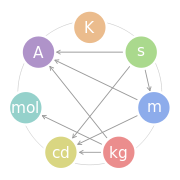Coulomb
|
|
|
| Unit system: | SI derived unit |
| Unit of... | Electric charge |
| Symbol: | C |
| Named after: | Charles-Augustin de Coulomb |
|
|
|
| 1 C in... | is equal to... |
| SI base units | 1 A s |
| CGS units | 2997924580 statC |
| Natural units | 6.242×1018 e |
The coulomb (symbol: C) is the SI derived unit of electric charge, and is approximately equal to the charge of 6.24151 × 1018 protons or −6.24151 × 1018 electrons.[1] It is named after Charles-Augustin de Coulomb.
Contents |
Definition
One coulomb is the amount of electric charge transported in one second by a steady current of one ampere.[2][3][4]
One coulomb is also the amount of excess charge on the positive side of a capacitance of one farad charged to a potential difference of one volt:
Explanation
In principle, the coulomb could be defined in terms of the charge of a proton or elementary charge. Since the values of the Josephson [5] constants have been given conventional values (KJ ≡ 4.835 979 × 1014 Hz/V and RK ≡ 2.581 280 7 × 104 Ω), it is possible to combine these values to form an alternative (not yet official) definition of the coulomb. A coulomb is then equal to exactly 6.241 509 629 152 65 × 1018 positive elementary charges. Combined with the present definition of the ampere, this proposed definition would make the kilogram a derived unit.
In everyday situations, positive and negative charges are usually balanced out. According to Coulomb's Law, two point charges of +1 C, one meter apart, would experience a repulsive force of 9 × 109 N, a force roughly equal to the weight of 900,000 metric tons of mass.
SI prefixes
| Submultiples | Multiples | |||||
|---|---|---|---|---|---|---|
| Value | Symbol | Name | Value | Symbol | Name | |
| 10−1 C | dC | decicoulomb | 101 C | daC | decacoulomb | |
| 10−2 C | cC | centicoulomb | 102 C | hC | hectocoulomb | |
| 10−3 C | mC | millicoulomb | 103 C | kC | kilocoulomb | |
| 10−6 C | µC | microcoulomb | 106 C | MC | megacoulomb | |
| 10−9 C | nC | nanocoulomb | 109 C | GC | gigacoulomb | |
| 10−12 C | pC | picocoulomb | 1012 C | TC | teracoulomb | |
| 10−15 C | fC | femtocoulomb | 1015 C | PC | petacoulomb | |
| 10−18 C | aC | attocoulomb | 1018 C | EC | exacoulomb | |
| 10−21 C | zC | not used | 1021 C | ZC | zettacoulomb | |
| 10−24 C | yC | not used | 1024 C | YC | yottacoulomb | |
| Common multiples are in bold face. | ||||||
See also SI prefix.
Conversions
- The magnitude of the electrical charge of one mole of protons (approximately 6.022 × 1023, or Avogadro's number) is known as the Faraday constant or a faraday. One faraday is equal to 96485.3399 coulombs. In terms of Avogadro's number (NA), one coulomb is equal to approximately 1.036 × NA × 10−5 elementary charges.
- one ampere-hour = 3600 C, one mAh = 3.6 C
- The elementary charge is 1.602176487 × 10−19 C
- One statcoulomb (statC), the CGS electrostatic unit of charge (esu), is approximately 3.3356 × 10−10 C or about 1/3 nC.
- One coulomb is the amount of electrical charge in 6.241506 × 1018 protons, or equivalently, negative one (-1) coulomb is the electrical charge of 6.241506 × 1018 electrons.
This SI unit is named after Charles-Augustin de Coulomb. As with every SI unit whose name is derived from the proper name of a person, the first letter of its symbol is uppercase (C). When an SI unit is spelled out in English, it should always begin with a lowercase letter (coulomb), except where any word would be capitalized, such as at the beginning of a sentence or in capitalized material such as a title. Note that "degree Celsius" conforms to this rule because the "d" is lowercase.—Based on The International System of Units, section 5.2.
See also
- Abcoulomb, a cgs unit of charge
- Ampère's circuital law
- Coulomb's law
- Electrostatics
- Elementary charge
- Faraday (unit), an obsolete unit
- Quantity of electricity
References
- ↑ [1] Electric Charge Prof. Joseph F. Becker, San Jose State University
- ↑ BIPM Table 3
- ↑ NIST: Table 3. SI derived units with special names
- ↑ BIPM SI Brochure, Appendix 1, p. 144
- ↑ CIPM (1988) Recommendation 1, PV 56; 19) and von Klitzing (CIPM (1988), Recommendation 2, PV 56; 20
|
||||||||||||||||||||


